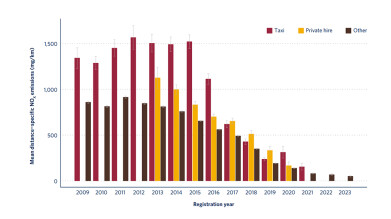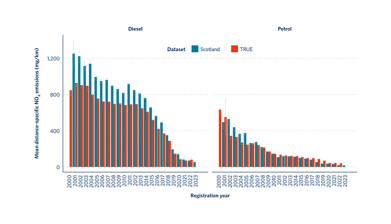-
 Figure 2. Mean distance-specific NOX emissions from diesel taxis, private hires, and other passenger cars by registration year. Whiskers represent the 95% confidence interval of the mean. Only registration years with over 100 measurements are presented.
Figure 2. Mean distance-specific NOX emissions from diesel taxis, private hires, and other passenger cars by registration year. Whiskers represent the 95% confidence interval of the mean. Only registration years with over 100 measurements are presented. -
 Figure 1. Mean distance-specific NOX emissions from diesel and petrol passenger cars by registration year for Scotland and all TRUE remote sensing data. Whiskers represent the 95% confidence interval of the mean. Only measurements of 100 or more are presented.
Figure 1. Mean distance-specific NOX emissions from diesel and petrol passenger cars by registration year for Scotland and all TRUE remote sensing data. Whiskers represent the 95% confidence interval of the mean. Only measurements of 100 or more are presented.
Air quality monitoring
Scottish city taxi NOx emissions 84% higher than passenger cars, says new TRUE report
Sep 02 2024
High-use vehicles like taxis are serious over emitters, says The Real Urban Emissions (TRUE) Initiative in a three-year study of 1.4 million vehicle emission measurements in Scotland.
The report 'Real-world vehicle emissions in four major Scottish cities: A comprehensive analysis of 2021–2023 remote sensing data' collected and analysed 1.4 million real-world vehicle emissions from Glasgow, Edinburgh, Dundee, and Aberdeen.
The study shows that diesel taxis and private hire vehicles emit significantly more nitrogen oxide (NOx) than passenger cars, due to the faster deterioration of their emission control systems as they are driven much more. Taxis registered between 2009 and 2016 produced 84% higher NOx emissions than passenger cars of the same age. In Dundee and Edinburgh, taxi and private hire fleet-average emissions rose despite introducing newer vehicles into the fleet, reflecting this trend. Further, some of the oldest diesel taxis fitted with diesel particulate filters (DPF) showed particulate matter (PM) emissions at levels which suggest these DPFs have either been removed entirely or are now seriously malfunctioning.
Newer diesel and petrol Scottish passenger models show significant improvements in real-world NOx emission performance, consistent with the introduction of more stringent tailpipe emission standards across Europe. For example, the most recent Euro 6d models produced 95% less NOx than Euro 3. Over the three years of testing, NOx emissions from private passenger cars decreased by 7% annually due to natural fleet turnover. However, some of the newest vehicle families (Euro 6d-TEMP and Euro 6d standards) were still shown to emit NOx above on-road emission (RDE) limits, with the worst offenders emitting more than double the limit.
The report also identified that Euro V trucks, some of the oldest in the fleet, are particularly prone to emission increases over time and are more likely to have defective or tampered emission control systems, which highlights the importance of identifying these trucks and removing them from the fleet.
This report makes a number of policy recommendations based on the findings, which include:
• Adding NOx emissions testing to the required annual national vehicle testing programme to identify and remove high polluters from the road;
• Introducing mileage or stricter age limits for taxis and private hire vehicles by local authorities;
• Policy measures to accelerate fleet renewal and a transition to zero-emission vehicles.
Derek McCreadie, Transport Scotland Air Quality Senior Advisor, said: "Remote sensing provides insight into real-world emissions of diesel and petrol vehicles in the urban environment, detecting emissions that diverge from the type-approval limit and typical levels. Now that Low Emission Zones have been introduced in four major cities, these technologies improve our understanding of real-world vehicle emissions and provide an evidence base for the delivery of policies to improve air quality and benefit the health of people in Scotland."
Sheila Watson, Deputy Director of the FIA Foundation, a core founder and partner of the TRUE Initiative, added: “It is shocking that the highest use vehicles in Scottish cities are the most polluting. Even when Dundee and Edinburgh taxi fleets are being upgraded to newer standards, their emissions are still getting worse. It is clear that there needs to be a change in how we move in urban areas. We have got to break the urban reliance on cars and shift to public transport, walking, and cycling for our environment and our health.”
"Analysing the results of this study over several years allowed us to build a better picture of real-world emissions in these four cities," says Kaylin Lee, researcher at the ICCT. "It allowed us to offer insights and provide recommendations that reflected the year-to-year changes in the fleets versus a single window of opportunity."
The Air Remote Sensing Project aimed to establish a database of real-world emissions from the Scottish fleet and inform the future development of the remote-sensing air quality monitor network in low-emission zones. Transport Scotland commissioned a consortium including TRUE partner the International Council on Clean Transportation, with Hager Environmental & Atmospheric Technologies (HEAT) and Environmental Resources Management (ERM) to gather and measure real-world emissions data from the Scottish fleet.
Digital Edition
IET 35.2 March
April 2025
Air Monitoring - Probe Sampling in Hazardous Areas Under Extreme Conditions - New, Game-Changing Sensor for Methane Emissions - Blue Sky Thinking: a 50-year Retrospective on Technological Prog...
View all digital editions
Events
May 10 2025 Karachi, Pakistan
May 11 2025 Vienna, Austria
May 11 2025 Seoul, South Korea
Salon Analyse Industrielle & Instrumentation
May 14 2025 Paris, France
May 15 2025 Istanbul, Turkey







_(4427399123)-(2).jpg)












